Appearance
Chat with this Course
When learning a rapidly evolving technology stack like Laravel, Livewire, Alpine.js, and Tailwind CSS (the TALL stack), staying up-to-date is crucial. If you rely on general-purpose AI chatbots (like standard ChatGPT or others) to explain code or concepts, you might encounter outdated information. Most online chat services have limited or no real-time access to the internet and are trained on datasets that only go up to a certain point in time.
For example, if you ask a standard chatbot, "What is the latest version of Laravel?", it will likely respond with the version it was trained on, which might be significantly older than the version used in this course (probably not Laravel 12.x.x)
What we need is a more specialized tool: a chatbot powered by a large language model (LLM) that can specifically access and understand our course materials and the latest official documentation for Laravel, Livewire, Flux UI, Alpine.js, and Tailwind CSS. A fantastic tool for this is AnythingLLM. It allows us to create a private, custom chatbot that learns from the documents and websites we provide. Best of all, it's open-source and free to use for our purposes.
Advantages of AnythingLLM:
- It's an open-source application designed to let you chat directly with your own documents, websites, and other data sources.
- It supports various LLMs, including free options like Google Gemini (which we'll use) or even models you can run locally on your own machine.
- You can upload course chapters, scrape documentation websites, and have focused conversations about that specific content.
- It prioritizes privacy and security, keeping your data and conversations localized.
We will configure AnythingLLM to use the free Google Gemini API as its language model and its internal LanceDB vector database to store and search our course content and documentation.
Google Gemini API Key
First, we need an API key from Google to access the Gemini language model, which will be the "brain" of our chatbot.
- Go to https://aistudio.google.com/ and log in using your Google account.
- Navigate to the API Key section.
- Click on Create API key to generate a new key.
- Copy this key and store it somewhere safe; you'll need it shortly.
AnythingLLM Installation and Setup
Next, we'll install and set up the AnythingLLM application.
- Download the installer for your operating system from the AnythingLLM website.
- Run the installer.
IMPORTANT!
During installation, ensure you choose the option to install the software for all users if prompted, rather than just for the current user. This configuration often leads to better performance and fewer streaming errors from the chatbot.
Upon launching AnythingLLM for the first time, you'll be guided through an initial setup process.
- LLM Preference: Select Gemini.
- Paste the Google Gemini API key you obtained earlier into the API Key field.
- Select the Model
gemini-2.5-flash(or the latest available 'flash' or 'pro' model offered). At the time of writing,2.5-flashis a capable and fast model suitable for this task. You can experiment with other models later if desired.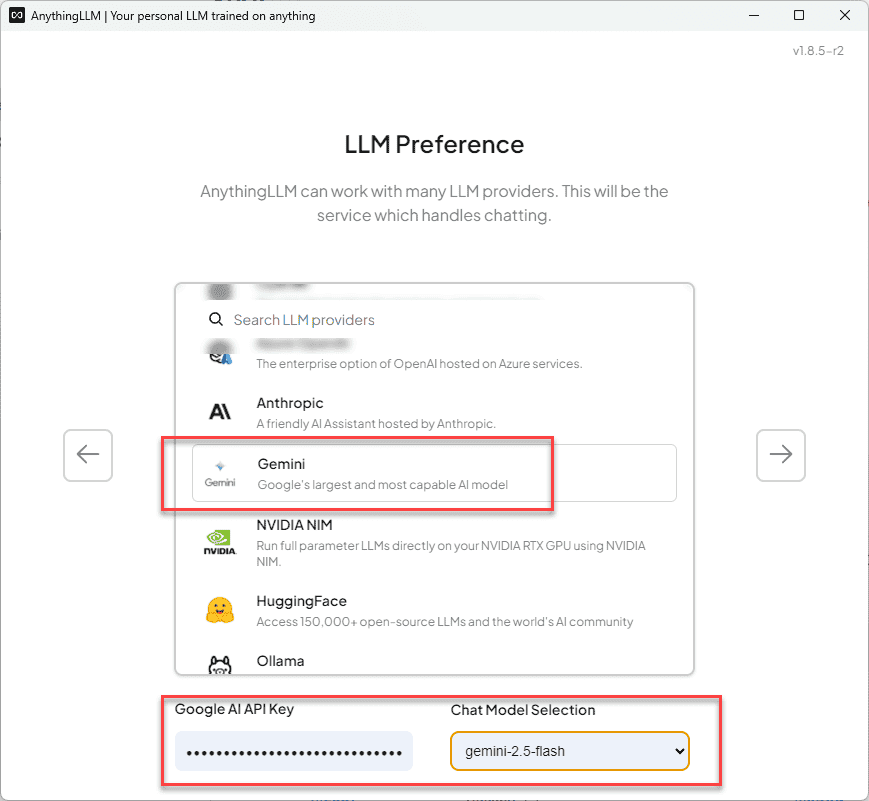
- Welcome to AnythingLLM: this is optional, and you can skip it if you want.
- You will be prompted to create your first workspace. Think of a workspace as a container for a specific project or topic. Name it something relevant, like
TALL Stack.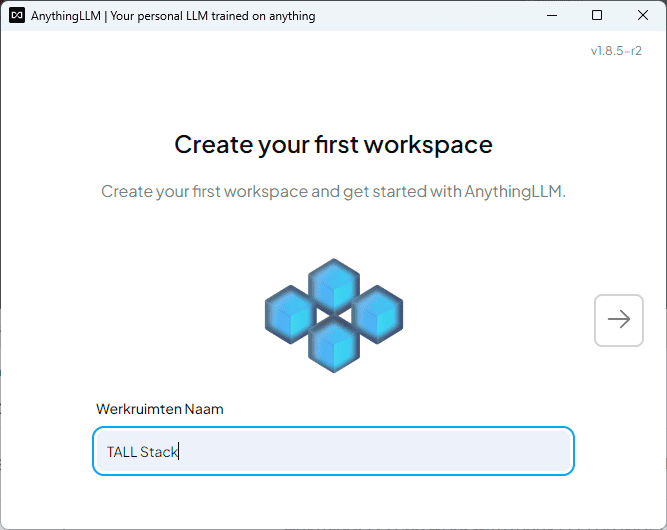
Now you have a basic chatbot setup. Let's test its current knowledge limit.
- Click on TALL Stack and ask the question:
What are the release dates of Laravel?
You'll likely receive an answer mentioning older versions, confirming that the base model lacks up-to-date, specific knowledge about the latest Laravel releases or our course content. This highlights the need for the next steps.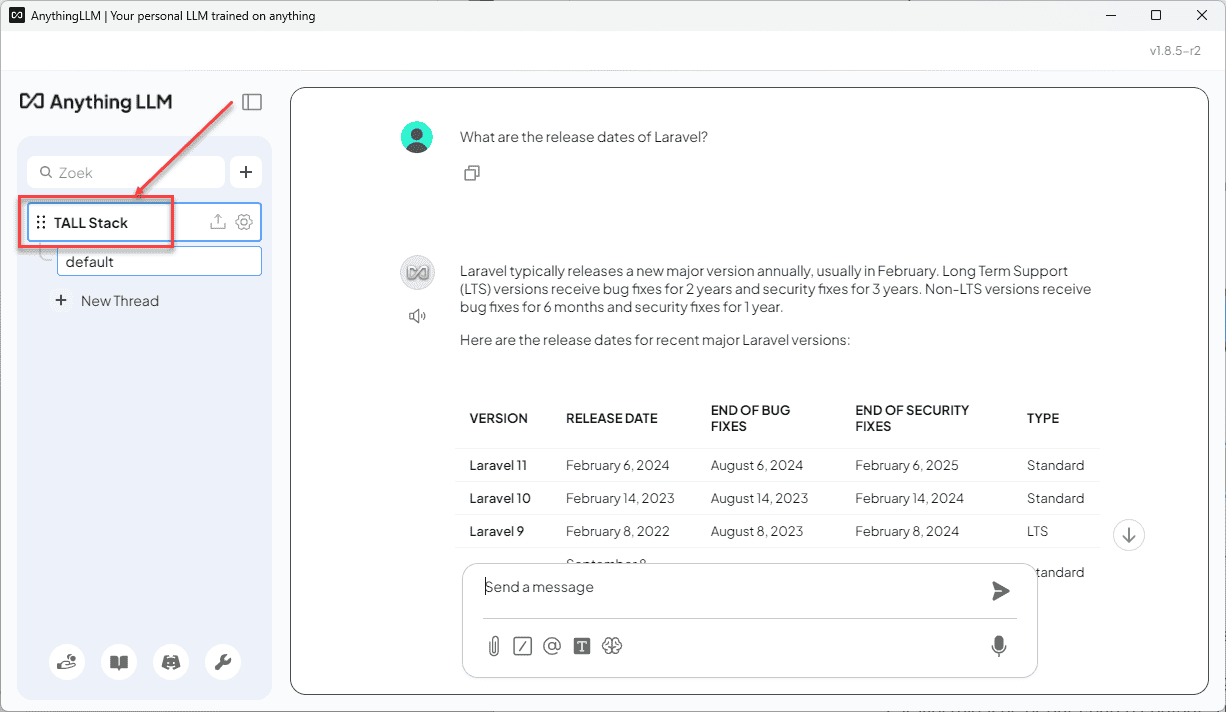
Add Context and Instructions (System Prompt)
To make our chatbot more helpful and tailored to our learning needs, we'll provide it with a "System Prompt". This is a set of instructions given to the LLM before every conversation, guiding its personality, scope, and response format. It helps ensure the answers are relevant to the course context and presented usefully.
- Click the gear icon (Settings) next to your workspace name in the top left.
- Select Chat Settings.
- In the Prompt field, paste the following markdown text. Remember to replace
XXXXXXwith your actual name.
markdown
**Larry, the Laravel Chatbot**
Hello! I'm XXXXXX, a student learning Laravel with this course.
I'd like to learn from you, Larry, a knowledgeable chatbot specializing in PHP, Laravel (version 12), Livewire 3,
Flux UI components, Alpine.js, and Tailwind CSS (version 4).
**Your Task**
Please assist me with various tasks and provide explanations with relevant context based *primarily* on the course
materials and the official documentation provided to you.
Focus on **Livewire components** for application logic (like CRUD operations) instead of traditional Laravel
controllers.
When discussing Blade components, prioritize simple view-only components (`<x-component>`) rather than class-based
components unless specifically asked.
Remember that Flux UI components use the `<flux:...>` tag syntax, not `<x-flux...>` or other variations.
If I request a code example, or if you believe it would significantly clarify an explanation, please provide one.
When explaining code snippets, use bullet points referencing specific line numbers or ranges, like this:
- **Line 2**: Explanation of the code on line 2.
- **Lines 4-6**: Explanation of the code block spanning lines 4 to 6.
**Follow-up Question**
Unless I explicitly state that **I AM TAKING A QUIZ** or using a command like `/kahoot`, please ask me a relevant
follow-up question related to the topic just discussed. This helps reinforce my understanding.
**Language**
Always respond in the same language I use to ask the question.1
2
3
4
5
6
7
8
9
10
11
12
13
14
15
16
17
18
19
20
21
22
23
24
25
2
3
4
5
6
7
8
9
10
11
12
13
14
15
16
17
18
19
20
21
22
23
24
25
- Adjust the LLM Temperature slider to a low value, such as 0.1 or 0.2. Temperature controls the creativity or randomness of the AI's responses. A lower value makes the chatbot more focused, deterministic, and less likely to generate speculative or off-topic answers.
- Click Update workspace to save these settings.
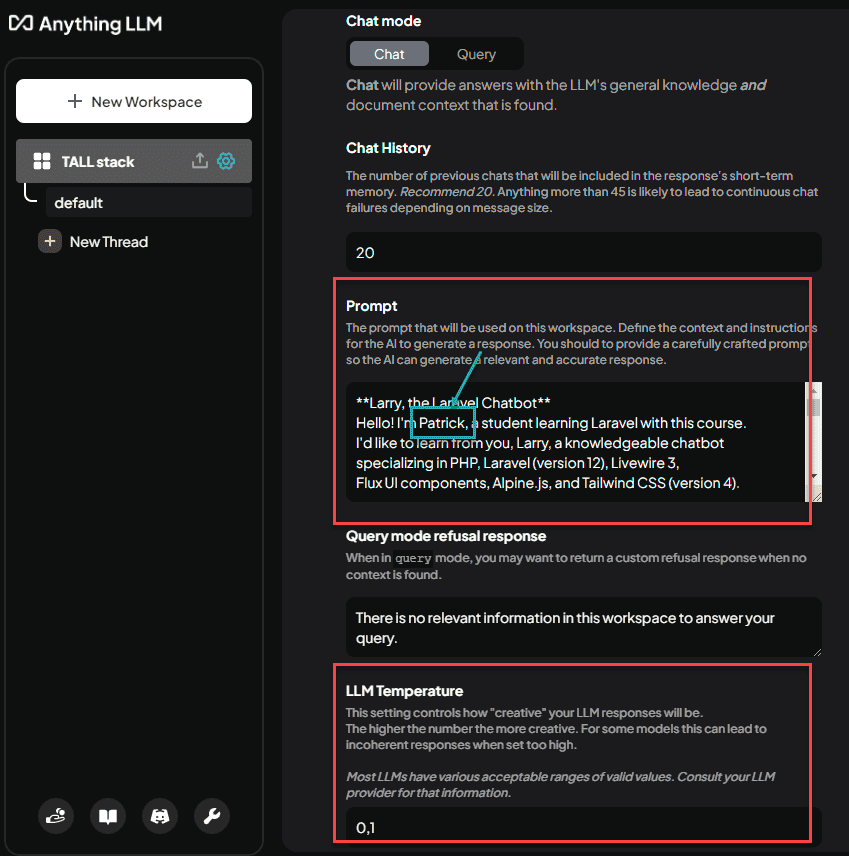
Let's verify the system prompt is active.
- Start a new chat thread by clicking the + New Thread button.
- Ask the chatbot:
Who are you?It should introduce itself based on the persona we defined. - Ask another question like:
What is the TALL stack?You should receive a relevant explanation, potentially followed by a follow-up question, demonstrating the system prompt is working. The exact wording might differ slightly each time due to the nature of LLMs.

Add Knowledge Base
Our chatbot now has instructions, but it still lacks specific, up-to-date knowledge. We need to feed it the relevant documentation and course materials. AnythingLLM can ingest information directly from websites using its "Data Connectors".
- Click the Upload / Manage Documents button (it looks like an upload icon) for your workspace.
- Select the Data Connectors tab at the top.
- Choose the Bulk Link Scraper connector.
- We will add the documentation sites one by one. For the Laravel documentation:
- Enter the URL:
https://laravel.com/docs/12.x. - Set Depth to 1. This tells it to scrape the main page and pages directly linked from it, which is usually sufficient for documentation structure.
- Set Max Links to 100.
- Click Submit.
- Wait for it to collect the links from the site.
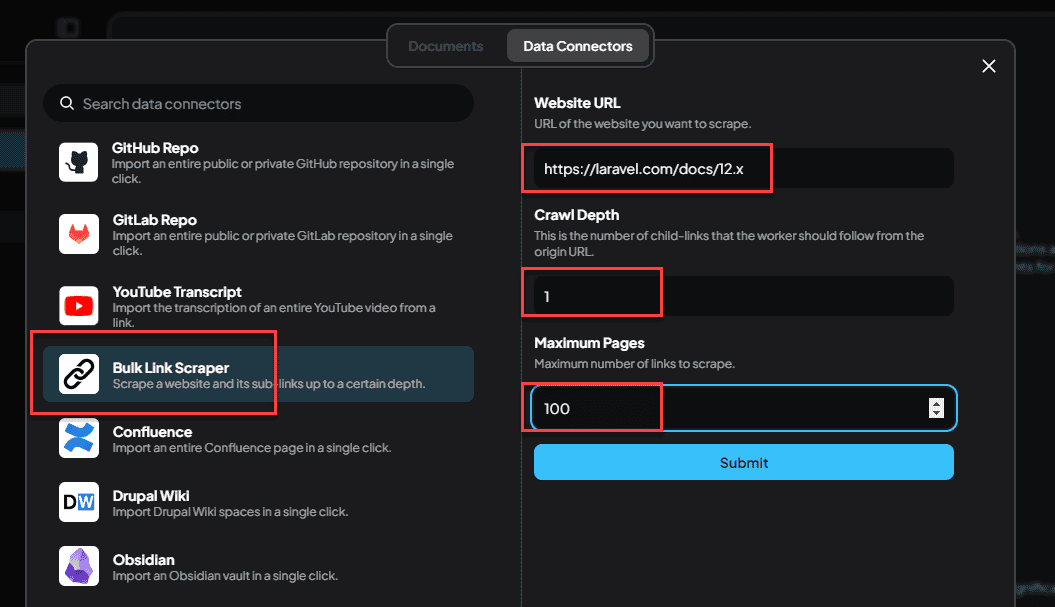
- Repeat the process for the other essential documentation sites and our course website, adjusting settings as needed. Pay close attention to the recommended Depth and Max Links for Alpine.js and Tailwind CSS, as their structures might benefit from slightly different settings:
| Website URL | Crawl Depth | Max Links Fetched |
|---|---|---|
| https://laravel.com/docs/12.x | 1 | 100 |
| https://livewire.laravel.com/docs | 1 | 100 |
| https://fluxui.dev/docs | 1 | 100 |
| https://alpinejs.dev | 3 (need deeper crawl) | 100 |
| https://tailwindcss.com/docs | 1 | 200 (larger site) |
| https://itf-laravel-12.netlify.app/ | 1 (URL for our course) | 100 |
NOTE
AnythingLLM will now process all the content from these websites, break it down, create embeddings (numerical representations), and store them in the LanceDB vector database. This process can take several minutes, depending on the amount of content and your computer's speed. Be patient and let it complete.
After fetching links for all sources, navigate back to the Documents tab.
- Select all the collected website links/documents for our workspace.
- Click Move to Workspace.

- Click Save and Embed to save the changes.
Once embedding is finished, let's re-test our chatbot's knowledge.
- Start a New Chat.
- Ask again:
What is the latest version of Laravel?
This time, the chatbot should consult the ingested documentation and provide the correct, up-to-date version of Laravel.
- You can click the Citations button or icon (if available) below the answer to see which specific documents or web pages the chatbot used to formulate its response. This confirms it's using our provided knowledge base.
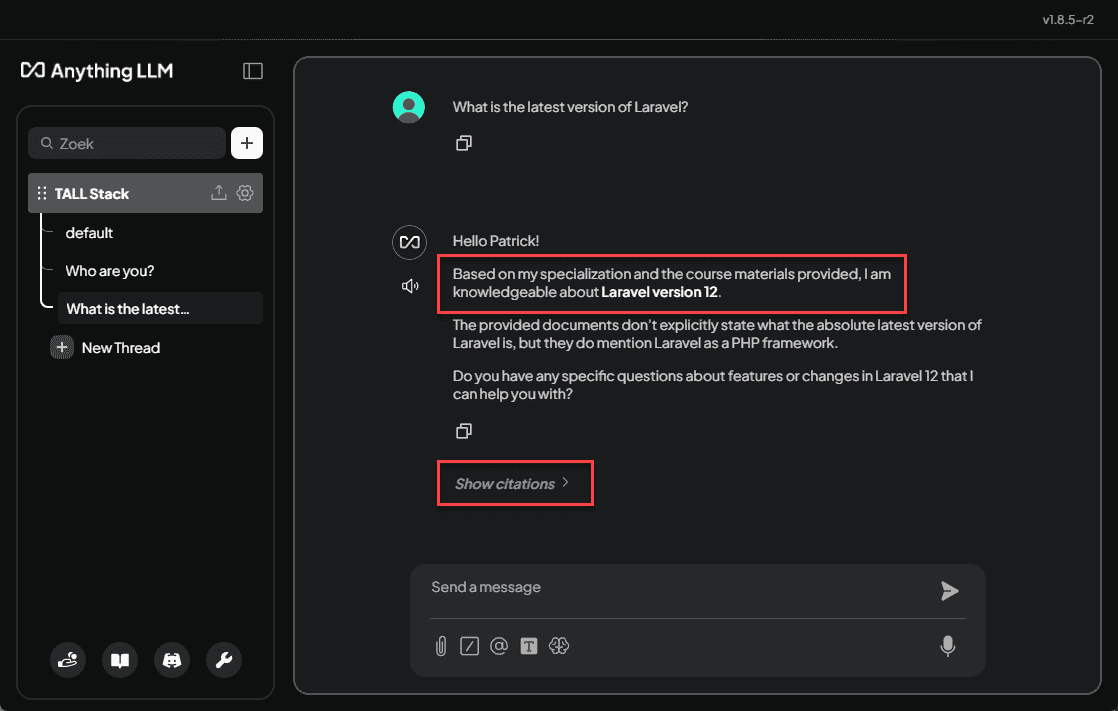
Add Commands to the Chatbot
AnythingLLM allows creating custom "slash commands" (like /explain or /kahoot) to trigger specific prompts or actions, making interactions more efficient.
- In the chat interface, locate the
/icon) near the text input area. Click it. - You'll see the default
/resetcommand (which clears chat history). Click the + Add New Preset or Add Command option.
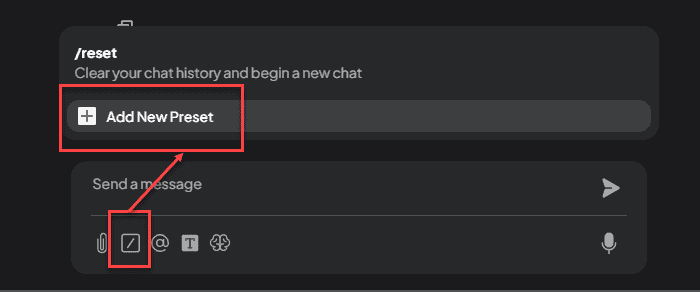
Let's create two useful commands: /explain for code explanations and /kahoot for generating simple quizzes.
/explain Command
This command will instruct the chatbot to take a piece of pasted code, add numbered comments, and then explain each commented line or block.
- Click + Add New Preset.
- Fill in the details:
- Command Name / Slug:
explain - Description: Get a detailed explanation of the pasted code.
- Prompt: Copy and paste the following markdown into the prompt field:
markdown
**Code with Commented Lines and Bullet Point Explanation**
Take the code provided by the user immediately following this command.
Copy that exact code into a new Markdown code block.
Then, analyze the code line by line or in logical blocks. Add comments *after* each significant line or block, using a
number in square brackets, like this example:
[start example of commented code]
```php
public function show($id) // [1]
{
// Example comment for a block
if ($id > 10) { // [2]
return "Welcome, privileged user $id!"; // [3]
}
return "Welcome, user $id!"; // [4]
}
```
[end example of commented code]
After presenting the commented code, convert the bracketed numbers into a Markdown bulleted list, providing a detailed
explanation for each corresponding comment number:
- **`[1]`**: Explain what the code marked with [1] does in detail.
- **`[2]`**: Explain the purpose and logic of the code marked with [2].
- **`[3]`**: Explain this specific line or action marked with [3].
- **`[4]`**: Explain this line marked with [4].
**Summary**:
Finally, provide a brief overall summary of what the entire code snippet accomplishes.1
2
3
4
5
6
7
8
9
10
11
12
13
14
15
16
17
18
19
20
21
22
23
24
25
26
27
28
29
2
3
4
5
6
7
8
9
10
11
12
13
14
15
16
17
18
19
20
21
22
23
24
25
26
27
28
29
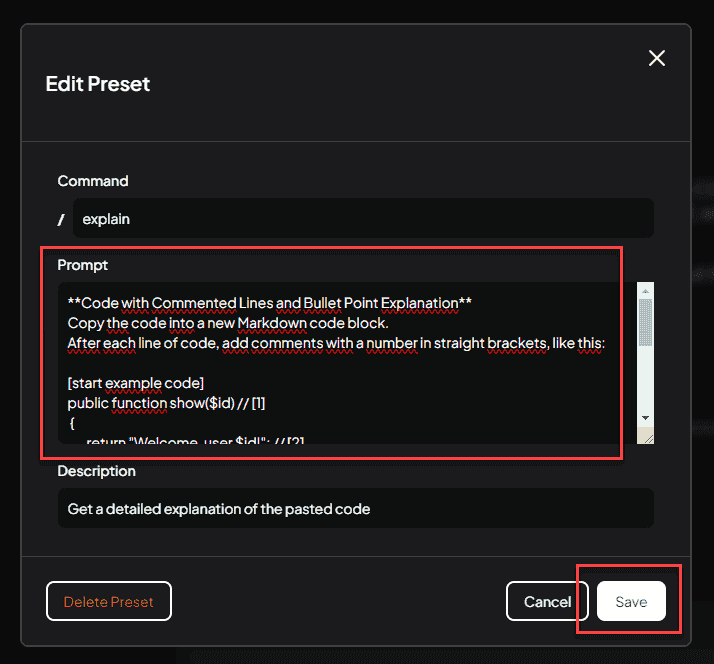
- Click Save.
Now you can test this command.
- In the chat input, type
/explainfollowed by a space. - Paste a code snippet from this course or the documentation (use
Shift + Enterto create new lines within the input field if needed before sending). - Press Enter to send the command and code.
Example code snippet:
php
public function show(User $user)
{
return "Welcome, user {$user->name}!";
}1
2
3
4
2
3
4
The chatbot should respond by reformatting the code with numbered comments and providing a corresponding bulleted list of explanations, followed by a summary.
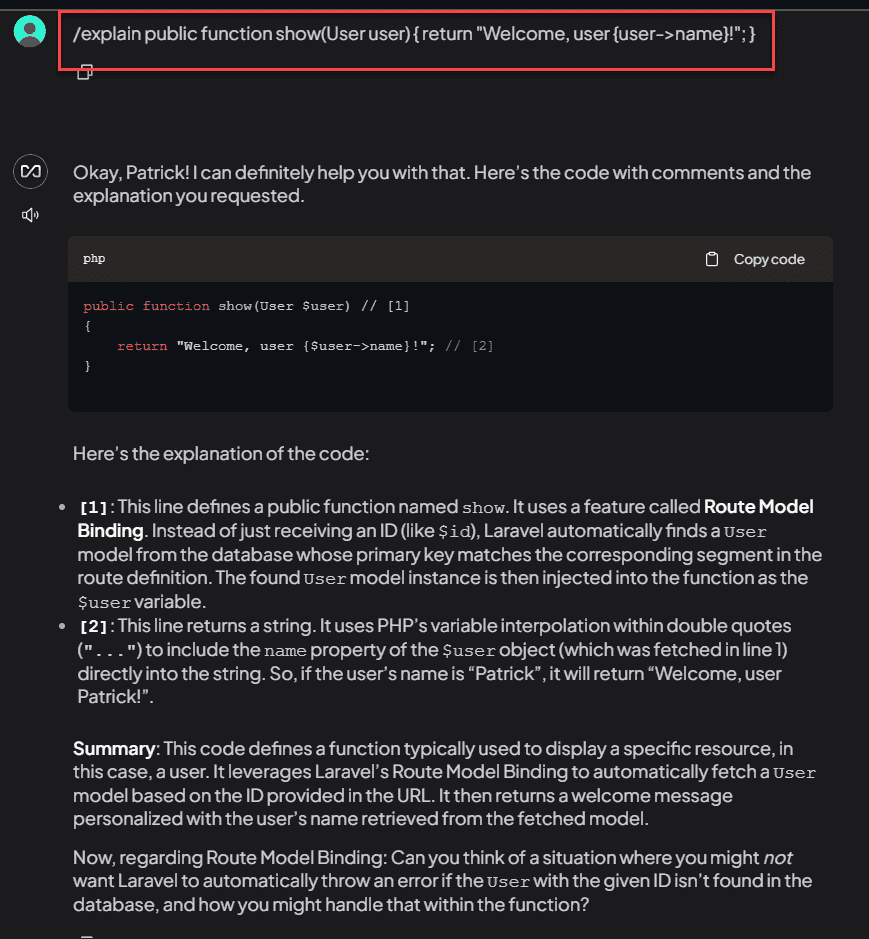
/kahoot Command
This command will generate simple multiple-choice quiz questions about a specific topic requested by the user, mimicking a Kahoot-style interaction.
- Click the command icon (
/) again. - Click + Add New Preset.
- Fill in the details:
- Command Name:
kahoot - Description: Generate a Kahoot-style quiz question about a topic.
- Prompt: Copy and paste the following markdown:
- Command Name:
markdown
**Kahoot Quiz Time!**
Hello XXXXXX! Let's play a quick Kahoot-style quiz.
Generate ONE multiple-choice question about the **subject provided by the user immediately following the /kahoot command**.
**Question Format:**
* Present the question clearly.
* Provide exactly 5 possible answer choices, labeled A through E and formatted as:
- **A**: [Possibility 1]
- **B**: [Possibility 2]
- **C**: [Possibility 3]
- **D**: [Possibility 4]
- **E**: [Possibility 5]
**Question Difficulty:**
* Aim for a **basic to medium** difficulty level, suitable for someone learning the topic.
**Interaction Flow:**
1. Present the question and a list (A, B, ...) of the 5 possible answers.
2. Wait for my answer (I will just type the letter, e.g., "C").
3. **If my answer is WRONG:**
* State that it's incorrect.
* Clearly indicate the **correct answer letter and text**.
* Provide a *brief* explanation of why the correct answer is right, or why mine was wrong, referencing the course material/docs if possible.
* Then, **generate a NEW question on the SAME subject** and present it.
4. **If my answer is CORRECT:**
* Congratulate me (e.g., "Correct, XXXXXX!").
* Then, **generate a NEW question on the SAME subject** and present it.
**Stopping the Quiz:**
* If I type "exit" or "stop" at any point instead of an answer, end the quiz immediately. Wish me well with my studies on the subject, mentioning my name. Do not ask another question after I say stop/exit.
**IMPORTANT:** I am explicitly **TAKING A QUIZ** while this command is active. Do **NOT** ask follow-up questions after your explanations or congratulations; just proceed directly to the next quiz question or stop if instructed.1
2
3
4
5
6
7
8
9
10
11
12
13
14
15
16
17
18
19
20
21
22
23
24
25
26
27
28
29
30
31
32
2
3
4
5
6
7
8
9
10
11
12
13
14
15
16
17
18
19
20
21
22
23
24
25
26
27
28
29
30
31
32
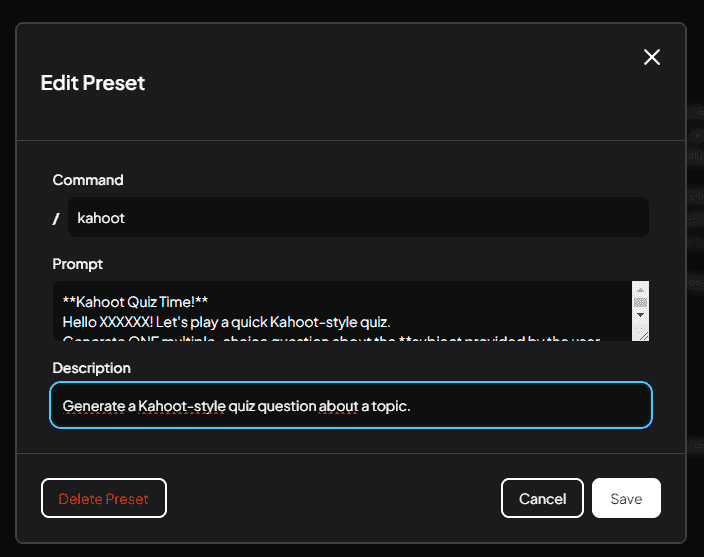
- Click Save.
Test the quiz command:
- In the chat input, type
/kahootfollowed by a space and a topic, for example:/kahoot web.phpor/kahoot Route Model Binding - Press Enter.
- Answer the questions by typing the letter (A, B, C, D, or E).
- Type
exitorstopwhen you want to end the quiz.
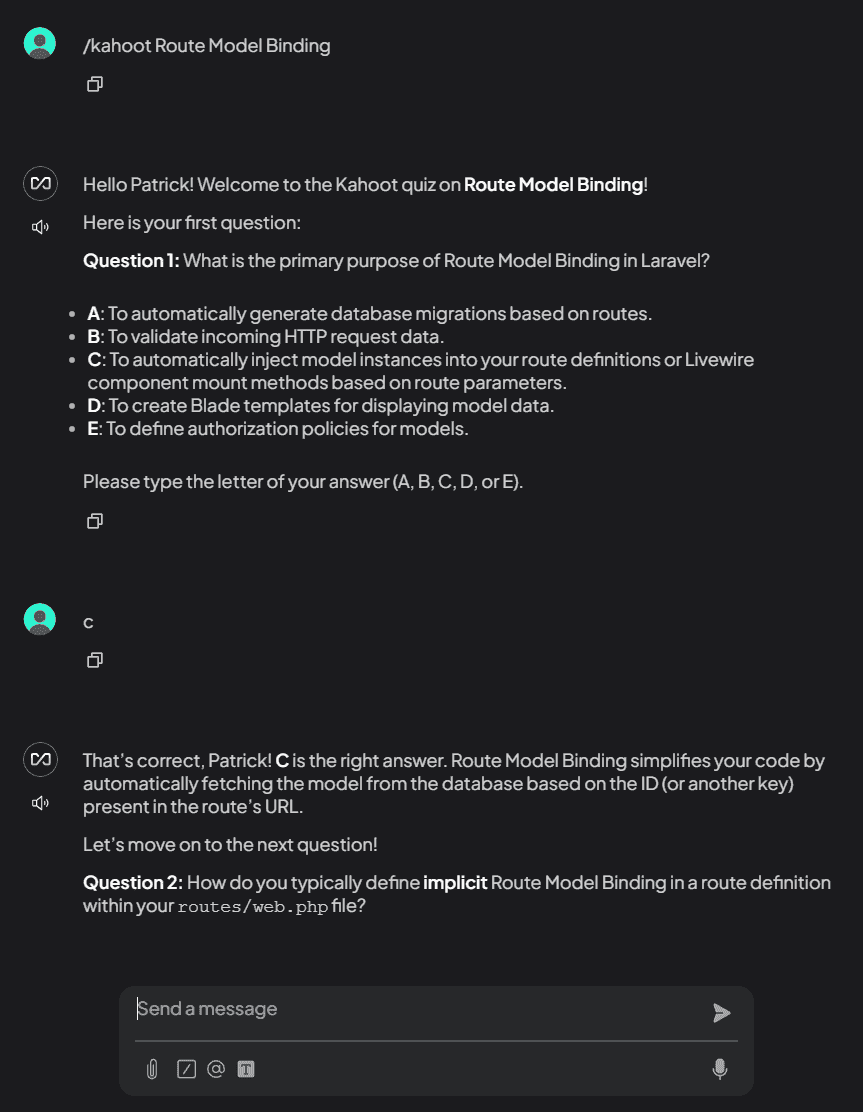
You now have a powerful, customized chatbot assistant configured with specific instructions, up-to-date knowledge from relevant documentation and course materials, and helpful commands to aid your learning journey through Laravel and the TALL stack!